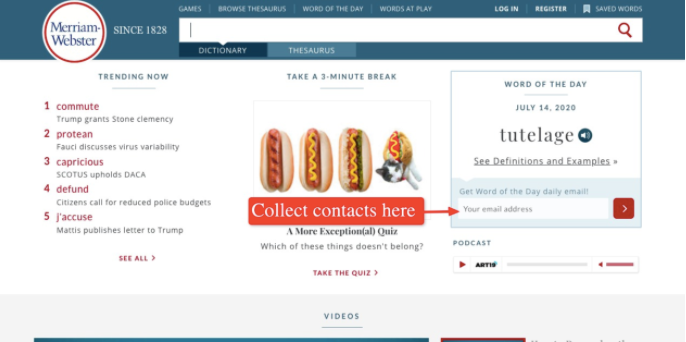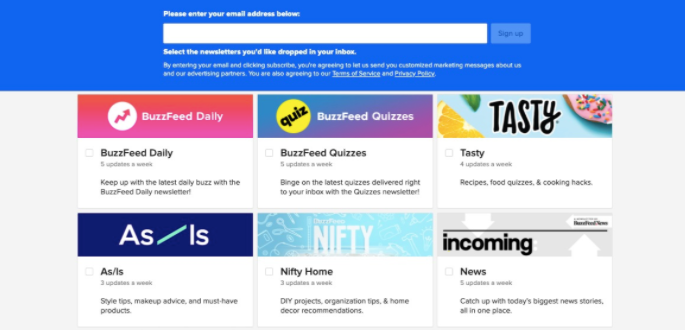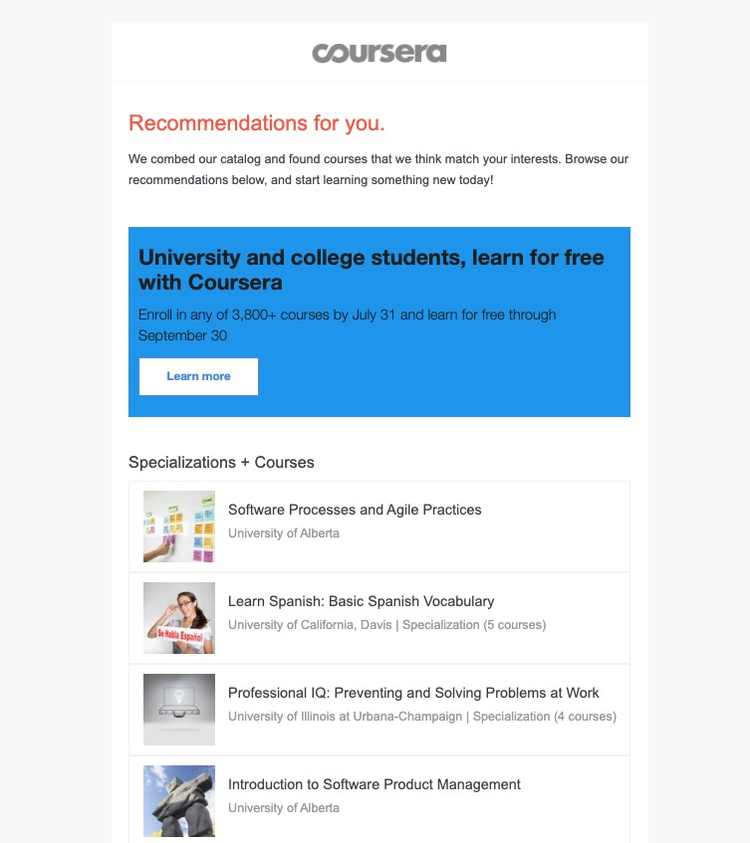You know the stats, right? Marketing industry beacon Martech Advisor says email marketing has an impressive ROI of 42:1.
But that's not even the best part. Add in email segmentation, and you not only improve open and click-through rates, but marketers have seen revenue bumps of up to 760%.
And that’s why you’ll want to figure out the best email marketing segmentation strategy for your small business. By integrating email segmentation, you take your small business email marketing to greater heights.
Overview: What is email segmentation?
Segmentation categorizes email subscribers into smaller groups according to specific criteria.
It’s a personalization technique that helps marketers and business owners deliver valuable and highly relevant email messages that are more targeted and specific to these sub-markets.
Segments can be based on demographic, interest, and/or purchase history, depending on your marketing strategy. For example, a fashion retailer may segment lists into men and women to send gender-specific promotions.
Knowing how to build an email list with proper segments will repay your efforts and time in better email campaign performance.
A study conducted by Mailchimp showed segmented campaigns generate:
- 100.95% more clicks
- 14.31% more opens
- 9.37% less unsubscribes
- 4.65% lower bounces
Moreover, research by Optimove found that smaller target groups produce larger uplifts. Target emails sent to a group with up to 150 contacts had a $1.90 uplift per customer, while groups with over 1,500 contacts produced a $0.50 uplift at most.
Segmenting similar contacts into smaller groups allows you to create custom content that’s relevant and engaging to your subscribers.
Questions to answer when creating email segments for your customers
Audience segmentation helps you understand your contacts and their needs. To create valuable email segments, ask yourself these questions.
1. Do you have permission to email them?
Getting recipient consent is a necessity for email marketing campaigns. It improves email deliverability and creates trust with your contacts.
Buying email lists or sending to email lists without permission is bad business. Avoid it. Beyond that, you risk violating rules of consent under the GDPR (General Data Protection Regulation) in the EU, and face hefty fines. Similar laws exist in the U.S. under the jurisdiction of the Federal Trade Commission (FTC).
Reputable email marketing software providers don’t recommend sending emails to purchased lists and might penalize your account if they find that’s what you’re doing.
Contacts must freely give consent by signing up for your email subscriptions. Every list or segment should come from a verifiable source proving your contacts consented to receiving your emails.
How you ask and log permission builds trust with your contacts while complying with data regulations.
2. Do you collect the right information?
Get the information you need to segment contacts. This will help you send the right content and boost response. With complete information, you can track your subscribers’ activity and create the right content for each segment.
These are some of the essential pieces of data you should collect:
- Contacts: Anyone your company communicates with, such as subscribers, leads, customers, and employees, among others.
- Contact properties: Information about an individual, such as their first name, last name, email address, location, interests, and more.
- Company and their properties: Information about a group of contacts from a single company, such as the company name, size, location, and URL.
Collect this data from form submissions on your landing pages or from chatbots and messenger apps.
For example, Merriam-Webster provides a small section to collect visitor email addresses on their homepage.

Merriam-Webster added an email opt-in form on their homepage to grow their email list. Image source: Author
Use this data to come up with a clearer picture of your ideal buyers and better segment your lists.
3. What do your contacts expect to receive?
Segment your contacts based on what they expect to receive. Clarify to your email list what, when, and why they will receive your emails so there are no surprises.
When you set proper expectations, the quality of your subscribers drastically improves since your list comprises people who know what they signed up for.
Remember that on average, people unsubscribe after 33 days. Add value during this period so you don’t give your list any reason to unsubscribe.
Being clear and direct cuts down unsubscribes and complaints. By putting a premium on clarity and brevity, you are bound to get better results from your email marketing campaigns.
10 smart email segmentation ideas for small businesses
You can segment your subscribers in various ways depending on your marketing goals. Try these examples of market segmentation for your email marketing strategy.
Idea 1: Content topic
Segment subscribers according to content type to reduce the unsubscribe rate.
You can segment contacts by:
- Content category or topic: Buzzfeed provides subscribers a choice of content and topics.

BuzzFeed allows their web visitors to sign up to various content categories. Image source: Author
- Type of content: Segment your subscribers according to the content they opted to receive, such as newsletters, sales promotions, job alerts, or exclusive content or deals.
Idea 2: Location
Location-based segmentation is perfect for local businesses and brick-and-mortar stores. This method lets you increase the relevance of your emails since you can include location-specific ideas in your content.
For example, you can send emails to tell locals about your upcoming events in their area. You can also feature famous non-competing brands in your area to make your emails look more organic and relatable.
Idea 3: Demographics
Segmenting your list by customer demographics lets you use a specific set of words and topics that resonate well with your readers.
You can segment based on gender, educational attainment, nationality, or marital status, and other parameters.
So, if your recently launched product is only for single men between 20 and 30 years old, you can create an email segment based on these parameters. That way, you can create your email newsletters with content that speaks directly to that demographic.
Idea 4: Birthday
Birthdate segmentation lets you connect with your subscribers on a more personal level. Send a simple birthday message, or offer a special deal to entice your subscriber to buy.
For example, Zalora provides an exclusive sitewide discount code as a birthday present.

Sitewide discount is offered by Zalora as a birthday promo. Image source: Author
Idea 5: Buying behavior
According to studies, if people buy from your store for the second or third time, they have a 54% chance of making yet another purchase. That’s the power of repeat business.
The data above shows the importance of studying your customer’s buying behavior. The more your customers buy from you, the easier it gets to entice them to buy again.
Based on this behavior, you can segment by looking into:
- Past purchases
- Purchase frequency
- Product type
- Loyal buyers
- Irregular buyers
- Seasonal buyers
- Benefit seekers
Idea 6: Buyer’s journey
Segment contacts based on their location in the buyer’s journey to ensure they receive the right content at the right time. In the awareness stage, send subscribers blog content, infographics, and ebooks that present both the consumer’s problem and its solution.
In the consideration stage, send them content that helps them evaluate their options through useful resources, webinars, events, and discounts. Near journey’s end, send them product demos and client testimonials to help them make informed decisions that would lead them to convert.
Streamline your email marketing funnel through this strategy to create a high-converting buyer’s journey.
Idea 7: Inactivity
Use your subscribers’ inactivity as your reference point to create highly engaging emails. Send a message asking how they are, or you can also send an irresistible offer -- something you’ll only share with someone who’s about to unsubscribe.
Segment your inactive subscribers in two ways:
- Put all inactive subscribers in a single segment.
- Group them based on inactivity duration, original segment, and other variables.
By segmenting your inactive users, you increase your likelihood of getting them to respond again to your emails.
Idea 8: New subscribers
Segment your new subscribers to nurture them early in your email campaigns. Send a welcome email to introduce your brand and set clear expectations about what they will receive.
Welcome emails have a 91.43% open rate, so leverage your initial emails to connect quickly and establish a relationship with your subscribers.
Idea 9: Interest
Use consumer behavior or interactions to segment according to subscriber interest. This email segmentation idea enables you to send email content you know your subscribers will like.
For example, Coursera recommends courses based on past enrollments to entice its users to take more classes.

Coursera sends course recommendations via email. Image source: Author
Idea 10: Event attendance
Segment your list according to the event they joined, their attendance status, or event topic.You can send future event invitations and relevant content offers to these segments.
You can even segment this group further based on those who registered but did not show up. You can send them personalized messages, perhaps offering a replay, PDF of the slide set, or other inducement.
Segment your lists to generate better engagements and conversions
Whether you’re using B2C or B2B email marketing, smart email segmentation can do wonders for your campaigns.
You can increase revenue and audience engagement, all while spending less compared to someone who’s running their campaigns without segmentation.
Our Small Business Expert
We're firm believers in the Golden Rule, which is why editorial opinions are ours alone and have not been previously reviewed, approved, or endorsed by included advertisers. The Ascent does not cover all offers on the market. Editorial content from The Ascent is separate from The Motley Fool editorial content and is created by a different analyst team.